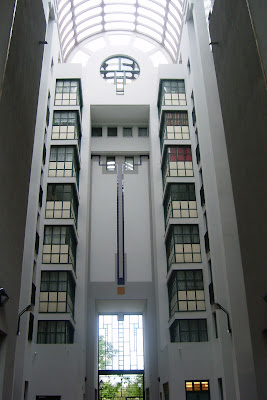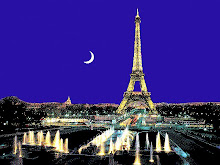June 30, 2007
Who can still afford...?
Some efforts, maybe not sufficient, are made in order to offer not only luxury lodging within the Paris city limits. There are laws and regulations which force the French municipalities to take the social aspect into account when allowing new building permits – more or less followed.
Where I live in Paris, the population is still quite well mixed. Most buildings are hundred years or older, but some fifteen minutes walking away we can find some examples of what has been done with regard to new constructing these last ten years. The buildings I show here are basically occupied by people who I suppose have a comparatively modest income. They have partly been built on what used to be a rail yard.
It seems to me that here the architects have at least tried to do something a little bit different and to create something which may seem acceptable for a decent living. Between the buildings, you can also find some green areas, playing grounds etc. … and you are still in Paris, not in a more or less far away situated suburb.
The surprising “green tower” building is actually very simple as such and without the pots on the balconies it would look extremely ordinary, but it's already some ten years old and the plants are still there and green (or almost all of them). However, what will it look like in another ten or twenty years? It’s clear that the Paris city buildings from e.g. the 19th century were made to last “for ever”. How long will these buildings still be nice? Maybe a necessary compromise? You build something really nice to be there "for ever" and then it gets too expensive.


Posted by Peter at 30.6.07 16 comments
June 29, 2007
Hermès
 Yesterday, Nathalie advised that the answer at last had been found after a question to and answer from local ABC News: It’s the logo for Hermès! (Too) simple! The Hermès Australian head quarters are situated in the building Nathalie had photographed!
Yesterday, Nathalie advised that the answer at last had been found after a question to and answer from local ABC News: It’s the logo for Hermès! (Too) simple! The Hermès Australian head quarters are situated in the building Nathalie had photographed!I should of course have known this before, but could now immediately confirm, as I also yesterday discovered the same statue on the top of the Hermès home building in Paris (rue du Faubourg St. Honoré). Here is what I found.
 So it’s just a simple un-named rider, used as a company symbol.
So it’s just a simple un-named rider, used as a company symbol.Hermès was founded in 1837 by Thierry Hermès as a saddlery company so the link to a horse is quite obvious. The soldier looks like being from the first half of the 19th century. Hermès is still family owned.
The silk scarves are produced since 1928 and today Hermès sells more than a million scarves per year. Among the leather goods you can still by a saddle, but the bestseller seems to be the “Birkin bag”. It was named after the actress Jane Birkin who co-designed it after complaining that her “Kelly” was not practical for daily use. The price of the bag starts at $6.000 and you have to order it year(s) in advance.
Posted by Peter at 29.6.07 28 comments
June 28, 2007
PALOMA

 Is this a paloma, dove of peace, colombe? I’m not a bird expert, but I know that there are quite a few among the bloggers, so we will hopefully know. At least to me it looks like one! I saw it yesterday among some pigeons in “my” park.
Is this a paloma, dove of peace, colombe? I’m not a bird expert, but I know that there are quite a few among the bloggers, so we will hopefully know. At least to me it looks like one! I saw it yesterday among some pigeons in “my” park.Let’s here “forget” about this bird as a symbol for peace, its significance in religion etc., known by everybody.
La Paloma is also a song, which is supposed to have the world record of number of recordings, several thousands. You would possibly believe it’s a folk song, but it was composed around 1860 by a Spanish composer (Iradier or Yradier). By the way, George Bizet thought that another song by the same composer was also a folk song and used it as basis for his “Habanera” in Carmen.


 My granddaughter is called Paloma. I believe I have already said this somewhere, but one reason for this name was that the whole big family saw the Almodovar film “Hable con ella” (“Talk to her”) a couple of weeks before Paloma’s birth and were extremely touched by the film and by Caetano Veloso’s performance of “Cucurrucu Paloma”.
My granddaughter is called Paloma. I believe I have already said this somewhere, but one reason for this name was that the whole big family saw the Almodovar film “Hable con ella” (“Talk to her”) a couple of weeks before Paloma’s birth and were extremely touched by the film and by Caetano Veloso’s performance of “Cucurrucu Paloma”. Posted by Peter at 28.6.07 31 comments
June 27, 2007
Vermeer, Modigliani...
I found these two ones, rue Cavalotti. When I passed was a Sunday – the reason the stores were closed – and nobody around to ask, but I have later found out that the two examples I can show you here actually were part of a series of similar ones in the same street, made in the late 90’s and supposed to represent different famous painters. These two are the only ones still in fairly good shape.
I would believe that the idea was not have paintings made as pure copies, but rather “à la manière de”, as if they had been painted by X. Anyhow, I have desperately looked for what could have been the originals, but have not found them.
One is as a “Vermeer” and the closest I could among the – unfortunately – very limited number of Vermeer paintings was “Lady in Blue”. The same lady seems to be more or less copied, but the fantastic Vermeer touch is of course missing. Anyhow, I don’t think that the “store artist” pretended to make anything as well as Vermeer; could anybody ever?
The other one is a “Modigliani” and also here I failed to find the original. I found one with a woman sitting in a similar position, although the baby is missing, and another one with a lady with a similar haircut. That’s the closest I could come, but the number of Modigliani paintings is of course much larger than the Vermeer ones.
Please feel free to look for the originals. I may be wrong.


Posted by Peter at 27.6.07 19 comments
June 26, 2007
Glass domes
Both these department stores started their activities in the late 19th century, but the present buildings are basically from the beginning of last century. The Galeries Lafayette dome was created in 1912 and the Le Printemps one in 1923.
These department stores are neighbors on Boulevard Haussmann. Just across the street, there is an old bank office, also with a fantastic glass dome. I took some pictures also there, but was kindly, but firmly, asked by some guards to delete them. If you want to see also this dome, you must go there.



The photos from this patchwork - and some more - can be seen on my other blog, "Peter - photos".
Posted by Peter at 26.6.07 28 comments
June 25, 2007
What time is it? (2) - A sun-dial
Just before World War I, someone came up with the idea to use this needle to create a sun-dial, but because of the war the idea was never finalised. The same idea came up just before World War II, with the same result. And, then again in 1999, there was a new try.
There is also a small mystery: Along one of the lines, obviously from the second try in 1938, there is a small copper plate with the inscription “Au levant de Thèbes surgit à Paris le Nord”, which is difficult to translate or even to understand in French. I managed to find a blog, where some experts have tried to interpret the text. There could possibly be a reference to the rising of Thebes and the (more recent) rising of Paris in the north, but no clear explanation seems to have been found. Maybe you can come up with it?

Posted by Peter at 25.6.07 32 comments
June 24, 2007
Fête de la Musique

Together with some friends we spent some ten hours in the streets. Not easy to show in pictures, but here are a few examples from small concerts around where I live, some bigger events around Trocadéro, the enormous crowd around la Bastille at midnight…
The metro worked all night, and you can see an example from a metro corridor; I have never seen the metro so full of people, all in good mood.
As this “Fête de la Musique” seems to spread around the world, you can perhaps comment on what possibly and hopefully happened at your place?



Posted by Peter at 24.6.07 14 comments
June 21, 2007
Music and friends...
Posted by Peter at 21.6.07 15 comments
Metro station Liège
The station, which is very close to the St. Lazare station, is fairly small and narrow; the quays are not opposite to each other as in all other stations. It was closed again in 1939 and opened only in 1968, then with a new decoration, which also is unique for a Paris metro station. The walls are covered with motives from the Liège region, made of tiles from Welkenraedt in the Liège province. I made my "discovery" thanks to my new “blogger eyes”.




Posted by Peter at 21.6.07 21 comments
June 20, 2007
Do you wish to "wash your hands"?
You can now find some nice improvement with modern and automatically cleaned public toilets, but they are of course completely without charm.
 There is one very nice public toilet which I would recommend. Not so easy to find, it’s situated to the right, just in front of the Madeleine church. It is by some considered as one of the most beautiful public toilets in the world. The entrance is covered by some nice mosaics. (Some refreshing would be recommended, but I understand that this is now under discussion by the local authorities.)
There is one very nice public toilet which I would recommend. Not so easy to find, it’s situated to the right, just in front of the Madeleine church. It is by some considered as one of the most beautiful public toilets in the world. The entrance is covered by some nice mosaics. (Some refreshing would be recommended, but I understand that this is now under discussion by the local authorities.)Once downstairs, you will find a beautifully tiled room, with individual stalls made of dark stained wood and stained glass. There is a chair for shoe shining, but nowadays only there for decoration. You will find a lady, who keeps the place nice and clean. You are supposed to give her something for the service, maybe 50 cents, but there is no fixed fee.
The toilets are there since 1905 and are now classified “historical monument”, so they will hopefully remain for long.


You can find the original photos from this patchwork on my other blog "Peter - photos".
Posted by Peter at 20.6.07 24 comments
June 19, 2007
Gare St. Lazare
 The St. Lazare station is the oldest railway station in Paris. The first line, between Paris and St. Germain (suburb), opened in 1837. The station was then actually close to the bridge (Pont de l’Europe) which you can see on the Google map. (Some of the photos, including the top one, are taken from this “Europe Bridge”, where Rue de Constantinople, Rue de Londres, Rue de Vienne, Rue de St. Petersburg, Rue de Liège and Rue de Madrid meet.) Rather quickly, needing more space for new lines, the station was soon moved to its present location.
The St. Lazare station is the oldest railway station in Paris. The first line, between Paris and St. Germain (suburb), opened in 1837. The station was then actually close to the bridge (Pont de l’Europe) which you can see on the Google map. (Some of the photos, including the top one, are taken from this “Europe Bridge”, where Rue de Constantinople, Rue de Londres, Rue de Vienne, Rue de St. Petersburg, Rue de Liège and Rue de Madrid meet.) Rather quickly, needing more space for new lines, the station was soon moved to its present location.The present station building was ready for the Universal Exposition in 1889 – as also the Eiffel tower. On one of my photos, you can see a bridge which connected the station to a big hotel which was then also built. The hotel is still there.
 Some of the impressionist painters used to live quite close to the station and it has frequently been painted. Monet made seven paintings in 1877.
Some of the impressionist painters used to live quite close to the station and it has frequently been painted. Monet made seven paintings in 1877.






 You can find the original photos from the patchwork above on my other blog - "Peter - photos".
You can find the original photos from the patchwork above on my other blog - "Peter - photos".
Posted by Peter at 19.6.07 33 comments
June 18, 2007
Street lamps
These last years a lot of attention has been given to maintain the original style of these lamps, considering that they play an important role for the decoration of our streets and open places. Many of them have been refreshed, repainted… Some of them may even be quite new, but in a design that fits to the architecture around them.
There were some rules about the need to lighten the streets which more seriously started to be applied during the 16th century, more or less based on oil lamps that the habitants were supposed to put in their windows, certain hours and months. During the 17th century, real street lamps started to be quite common. This meant a lot for the security and safety and led to the beginning of a real “Paris by night”-life. Gas lighting became common as from the beginning of the 19th century, but my report about the lamp post at Place de la Concorde (June 11) mentioned that electricity was introduced already in 1844. Today of course everything is electric (but I understand that modern gas lighting still can be found in some major cities around the world).




Posted by Peter at 18.6.07 19 comments























